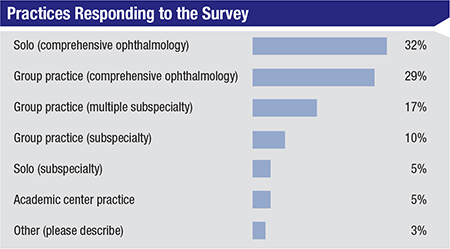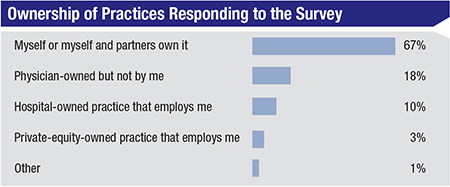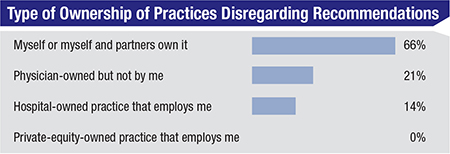From the Editors of Review of Ophthalmology  | ||||
Survey: Ophthalmologists’ Practices Try to Survive Pandemic The novel coronavirus pandemic has had a profound negative impact on all aspects of life, from our personal health to our workplaces to the economy as a whole. Currently, the $2 trillion coronavirus relief bill is heading toward the House of Representatives for a vote. In the meantime, via an email survey, ophthalmologists shared with us their fear and uncertainty over what might happen to their practices during this time, as well as some of the measures they’re taking to try to stay afloat. The survey was completed by 146 of your colleagues. Here’s a look at their responses.
Feeling the Effects Though the potential economic stimulus package from the government will take a lot of the sting out of ceasing most operations at a practice, until the checks start arriving, ophthalmologists say that stopping the regular patient visits per the AAO’s recommendation is hitting them hard. They shared their thoughts on the subject via the survey: •“We are burning through capital reserves to keep employees for when we return to full patient care. Ceased all not critical purchases.” •“We have very limited revenue; we’re thinking of furloughing most employees. The patients overall have been very understanding.” •“We’ve laid off all of our staff.” •“It’s been a financial hit as I am continuing to maintain full payroll for all employees despite marked decreases in patients and hours.” •“We are trying to maintain staff, but this is majority of expense with insufficient revenue to cover. Can tolerate for 2-4 weeks, but any longer will result in furloughs.” •“I am in a solo practice with $11,000 overhead per month. I must stay safe and keep my staff paid and my patients safe. However, I’m not sure if glaucoma patients on new meds should be considered "urgent" etc.—things are very uncertain.” •“We’re losing $50,000 per month. We’ll close if this goes on longer than six weeks. Implementing employee layoffs. We’re losing patients to ODs that remain open.” •“Our staff has been furloughed and have applied for unemployment insurance. No significant cash reserves. Considering SBA loan.” •“Seeing only emergency patients has tanked [the practice] almost completely; we’re maybe now down to two visits per day, but still have staff, rent, usual expenses with enough cash for four to six weeks of scaled-back office hours.” •“It has caused a 90-percent reduction in revenue. We’re laying off all non-essential personnel. One doctor is going in per day to minimize exposure, and prevent office closure. Telemedicine was instituted yesterday, in the hope to improve patient relationships and to risk to patients. Meeting next week to discuss financial plan for immediate and long-term financial strategy in the event this crisis continues for more than eight weeks.” •“We’ve cut clinic schedules, full-time employees to 24 hours, laid off a couple part-time employees. Partner doctors expect to go unpaid for some period of time and one doctor’s contract was terminated two months early.” •“Ninety-nine percent of patients are appreciative. Landlords, tax authorities, Insurance bills, and utilities and EMR/Cyber partners have been callous, demanding on-time payments while we have near zero income stream.” Bypassing the AAO’s Recommendations Though most of the survey’s respondents said they’re following the American Academy of Ophthalmology’s instructions to only care for urgent or emergency cases, 20 percent of the physicians (n=29) say they’re overriding the AAO’s recommendations and seeing other types of patients as well. In terms of ownership, most of the respondents who aren’t following the AAO recommendations either own their own practice or own it with physician partners (66 percent). Around a fifth of the physicians not following the guidelines are employed in physician-owned practices. Though some of the respondents not following the guidelines are physicians who work in hospital-owned practices, based on their comments, they appear to be on the cusp of following the guidelines. None of the respondents in practices owned by private-equity concerns (3.4 percent of the total survey respondents) are countermanding the AAO’s recommendations.
In their own words, here is why some of the physicians aren’t following the Academy’s instructions: •“I have sufficient personal protective equipment, and the infection rate very low in [my area] El Paso. Patient exposure risk lower in the office than at grocery store, bank or gasoline station. We are also testing for COVID-19 for any patients with symptoms.” •“The AAO is not paying our rent and office staff. Our patient load is 50-percent less regardless.” •“Because the practice will not exist after our politicians have finished destroying the economy otherwise.” •“We’re in a very rural area—there are no positive COV-19 cases in our county or surrounding counties.” •“We’re also examining postoperative patients.” •“We had a lot of patients scheduled and virus was not endemic in our area.” •“We’re leaving [the decision] up to patients •“We have reduced volume and are keeping our spacing to the recommended 6 feet. We’re using masks and are cleaning with 10% bleach solutions as well as hand washing with soap for 20 seconds. Our community has reported 10 cases.” •“[In addition to emergencies and urgent cases] we’re also seeing chronic, but potentially vision-threatening, conditions since the penetration of the virus in our area is extremely low.” •“[We’ve received] no guidance: What is ‘not urgent’?” •“The owners not closing ... personally, however, I’m sending non-emergency patients back for rescheduling.” What Physicians Can Do The approximately $377 million stimulus package would provide the lion’s share of the aid most practices need at this time, especially the loans for payroll, mortgage and rent. In the interim, physicians shared some of the things they’ve had to do to make ends meet, which often includes attempts at telemedicine and intense negotiations with creditors. The physicians shared their suggestions on what might be done during this precarious financial time: •“See only emergency department’s patients and screen them appropriately. No waiting room patients. No accompanying visitors with them.” •“Call patients to give them peace of mind and let them know they’re not abandoned. Possibly convert to telehealth exams. Your business will bounce back once this recovers. But you have to follow social distancing and quarantine to stay healthy and end this pandemic.” •“Talk openly with your staff. They know what’s happening in the world. Lay off most of staff and operate phones, urgent cases, pharmacy refills etc. I asked each laid-off staff member to clean their desks and leave a note saying ‘Welcome Back.’ Stay in contact with them. Encourage staff to remain in contact with each other. Cancel all non essential services. Cancel auto-ordered supplies. Draw on business and personal credit lines immediately—pay the interest for a few (one to six?) months. Cash is king during a disaster. Call patients. Advise them that things are changing hourly. Most are knowledgeable and understanding. Leave signs on your doors regarding CDC and AAO directives so patients don’t think it’s only your office. •“Get loans, reduce employment to 75-percent time and institute mandatory use of paid time-off first and pray we will through this in less than two months.” •“We’re answering calls with call forwarding to the home of our front-desk person. Emergencies are being answered by telephone and for dire emergencies the doctor will come in.” •“Limit hours and—I hate to say it—furlough your staff, talk to landlord about deferring part of the rent, and limit ordering nonessential supplies.” •“It’s very scary at this time, both medically and fiscally. Telemedicine would be tough for ophthalmologists for non-obvious cases.” •“We are exploring telemedicine but there is limited application in ophthalmology. We have decreased partner pay to zero and hoping to restructure practice loans to interest only.” •“We’re negotiating with most vendors and banks to delay payments or do interest-only payments. We may eventually have to lay off employees short-term.” •“Use tele-health. As soon as it’s reasonable in low-COVID-penetration areas, open the office with the ability to see patients and do elective procedures on a reduced basis using appropriate precautions.” •“Honestly? Not much [you can do] other than just biting the bullet and paying some semblance of salary, in a meaningful amount, to keep the hourly employees from falling apart. We'll need them in a couple of months. I never stopped taking call, inpatient consults or doing trauma. So there is still that for a trickle of work and have added telehealth when possible.” •“Let staff apply for unemployment funds. Have some staff available for emergencies. Have accounts receivable and payable staff come in one day per week, monitor and reroute faxes to staff members on laptops at home come in one day per week for eRXs. Keep good communication with staff. Delay payments or doctor salaries if possible. Consider accessing line of credits or obtain SBA low interest loans.” •“We’re embracing the telemedicine options and offering this option as a substitute for chronic care visits such as glaucoma visits. It gives us an opportunity to answer questions, reinforce medication regimens, and ask if the patient has an adequate supply of medicine. Our billing department is also taking advantage of this time, with reduced working on the billing side to follow up on the accounts receivable.” •“Telemedicine isn’t really helpful. Cutting staff and violating the [AAO’s] recommendations are the only way to stay in business if this goes on very long. Otherwise … close.” Review will continue to follow the pandemic and its effects on ophthalmology, both in print and via our social media platforms and e-mail updates. | ||||
|
Review of Ophthalmology® is published by the Review Group, a Division of Jobson Medical Information LLC (JMI), 19 Campus Boulevard, Newtown Square, PA 19073. To subscribe to other JMI newsletters or to manage your subscription, click here. To change your email address, reply to this email. Write "change of address" in the subject line. Make sure to provide us with your old and new address. To ensure delivery, please be sure to add reviewophth@lists.jobsonmail. Click here if you do not want to receive future emails from Review of Ophthalmology. |



